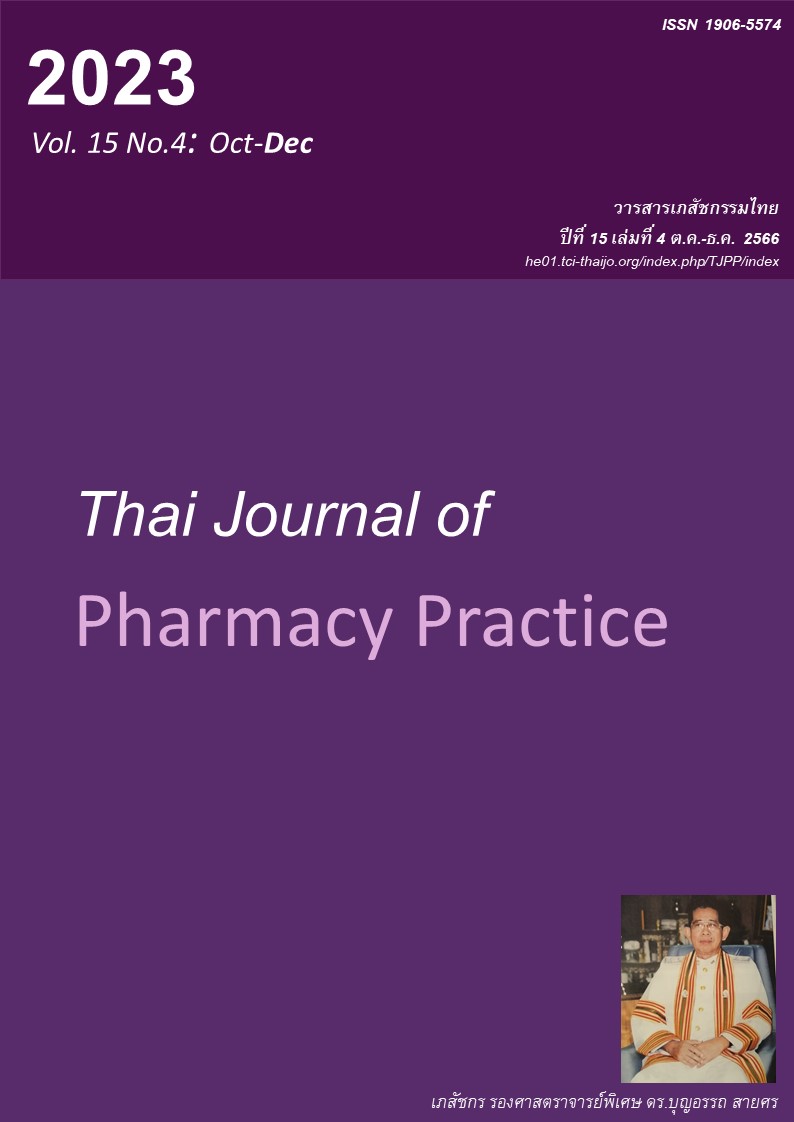ปัจจัยที่มีอิทธิพลต่อภาวะหมดไฟของเภสัชกรในโรงพยาบาลศิริราช
Main Article Content
บทคัดย่อ
วัตถุประสงค์: เพื่อศึกษาอุบัติการณ์ภาวะหมดไฟและปัจจัยทำนายภาวะหมดไฟของเภสัชกรในโรงพยาบาลศิริราช วิธีการ: การศึกษาใช้แบบสอบถามรูปแบบกระดาษเพื่อรวบรวมข้อมูลส่วนบุคคล สัมพันธภาพกับเพื่อนร่วมงาน หัวหน้างาน และครอบครัว ความเครียด และภาวะหมดไฟในเภสัชกรจำนวน 230 คนในโรงพยาบาลศิริราช การวัดภาวะหมดไฟใช้แบบสอบถามวัดภาวะหมดไฟในการทำงานสำหรับเจ้าหน้าที่สาธารณสุข จำนวน 22 ข้อซึ่งพัฒนามาจากแบบสอบวัดภาวะหมดไฟของ Maslach ภาวะหมดไฟในการทำงานประกอบด้วย 3 ด้าน ได้แก่ ความอ่อนล้าทางอารมณ์ การลดค่าความเป็นบุคคล และการลดค่าความสำเร็จส่วนบุคคล ผู้ที่มีภาวะหมดไฟ คือ ผู้ที่มีคะแนนในระดับสูงอย่างน้อย 1 ด้าน ซึ่งหมายถึงผู้ที่มีระดับความอ่อนล้าทางอารมณ์สูง (27-54 คะแนน) หรือมีระดับการลดค่าความเป็นบุคคลสูง (13-30 คะแนน) หรือมีระดับการลดค่าความสำเร็จส่วนบุคคลสูง (39-48 คะแนน) ผลการวิจัย: อัตราการตอบแบบสอบถามกลับที่สมบูรณ์เท่ากับร้อยละ 77.8 เภสัชกรส่วนใหญ่เป็นเพศหญิง (ร้อยละ 82.1) มัธยฐานของอายุ (พิสัยระหว่างควอไทล์) คือ 34 ปี (30-38) อายุงานมีมัธยฐาน 10 ปี (5-13) ความอ่อนล้าทางอารมณ์มีคะแนนเฉลี่ย 18.6±10.44 (จากคะแนนเต็ม 54) การลดค่าความเป็นบุคคลมีคะแนนเฉลี่ย 9.0±5.94 (จากคะแนนเต็ม 30) และการลดค่าความสำเร็จส่วนบุคคลมีคะแนนเฉลี่ย 15.4±9.09 (จากคะแนนเต็ม 48) สำหรับเภสัชกรที่มีภาวะหมดไฟในการทำงานพบร้อยละ 29.6 ซึ่งเป็นผู้ที่มีระดับความอ่อนล้าทางอารมณ์สูง การลดค่าความเป็นบุคคลสูง และการลดค่าความสำเร็จส่วนบุคคลสูง ร้อยละ 20.7, 24.0 และ 0.6 ตามลำดับ ปัจจัยที่สามารถทำนายภาวะหมดไฟได้อย่างมีนัยสำคัญทางสถิติ ได้แก่ คะแนนความเครียด (b=0.326, P<0.001) ความคิดอยากลาออกจากการทำงานภายใน 1 ปี (b=1.228, P=0.003) และการทำงานที่มีความท้าทายหรือส่งเสริมให้เกิดการเรียนรู้ (b=-0.948, P=0.015) สรุป: การศึกษานี้ทำให้ทราบถึงขนาด ความรุนแรงและปัจจัยที่มีผลต่อภาวะหมดไฟของเภสัชกรในโรงพยาบาลศิริราช ซึ่งจะเป็นข้อมูลแก่ผู้บริหารในการหาวิธีป้องกันและแก้ไขปัญหาภาวะหมดไฟของเภสัชกรต่อไป
Article Details

อนุญาตภายใต้เงื่อนไข Creative Commons Attribution-NonCommercial-NoDerivatives 4.0 International License.
ผลการวิจัยและความคิดเห็นที่ปรากฏในบทความถือเป็นความคิดเห็นและอยู่ในความรับผิดชอบของผู้นิพนธ์ มิใช่ความเห็นหรือความรับผิดชอบของกองบรรณาธิการ หรือคณะเภสัชศาสตร์ มหาวิทยาลัยสงขลานครินทร์ ทั้งนี้ไม่รวมความผิดพลาดอันเกิดจากการพิมพ์ บทความที่ได้รับการเผยแพร่โดยวารสารเภสัชกรรมไทยถือเป็นสิทธิ์ของวารสารฯ
เอกสารอ้างอิง
Maslach C, Jackson SE, Leiter MP. Maslach Burnout Inventory manual. 3rd ed. Palo Alto, CA: Consulting Psychologists Press; 1996.
Zeytinoglu IU, Denton M, Davies S, Baumann A, Blythe J, Boos L. Retaining nurses in their employing hospitals and in the profession: effects of job preference, unpaid overtime, importance of earnings and stress. Health Policy 2006; 79: 57-72.
Saelor C, Puttapitukpol S. Factors affecting job burnout of professional nurses in Suratthani hospital. Journal of the Police Nurses. 2017; 9: 95-103.
Swangjang J, S H. Stress of sale representatives of international companies in Bangkok area. Chulalongkorn Medical Journal. 2009; 53: 531-43.
Saijo Y, Yoshioka E, Hanley SJB, Kitaoka K, Yoshida T. Job stress factors affect workplace resignation and burnout among Japanese rural physicians. Tohoku J Exp Med. 2018; 245: 167-77.
Jones GM, Roe NA, Louden L, Tubbs CR. Factors associated with burnout among US hospital clinical pharmacy practitioners: results of a nationwide pilot survey. Hosp Pharm. 2017; 52: 742-51.
Gupchup G. Burnout in a sample of HMO pharmacists using the Maslach Burnout Inventory.
J Manag Care Pharm. 1998; 4: 495-503.
Dugani S, Afari H, Hirschhorn LR, Ratcliffe H, Veillard J, Martin G, et al. Prevalence and factors associated with burnout among frontline primary health care providers in low-and middle-income countries: a systematic review. Gates Open Res. 2018; 2: 1-14.
Siwakarn W, T.Sriwong B. Job burnout in hosptial pharmacists, office of the permanent secretary of the Ministry of Public Health. Silpakorn Educational Research Journal. 2011; 2: 331-41.
The Healthcare Accreditation Institute (Public Organization). Burnout and mental health disorder. In: The Healthcare Accreditation Institute (Public Organization), editor. Personnel safety goals: SIMPLE Thailand 2018. Nonthaburi: The Healthcare Accreditation Institute (Public Organization); 2018. p. 31-3.
Bhunnachet T, Kwantamrong A. Factor affecting student’s burnout at faculty of pharmacy, Mahidol University [dissertation]. Bangkok: Mahidol University; 2020.
Department of Mental Health. Stress Questionare (ST-5) [Online]. 2019 [cited Feb 21, 2021]. Available from: dmh.go.th/test/qtest5/.
Maslach C, Jackson SE. The measurement of expe- rienced burnout. J Organ Behav. 1981; 2: 99-113.
Summawart S. Burnout among the staff nurses in Ramathibodi hospital [master thesis]. Bangkok: Mahidol University; 1989.
The Seventh Mental Health Center at Khon Kaen. Burnout questionnaire for healthcare worker [online]. 2017 [cited Feb 21, 2021]. Available from: mhc7.go. th/archives/5996.
Durham ME, Bush PW, Ball AM. Evidence of burnout in health-system pharmacists. Am J Health Syst Pharm. 2018; 75: S93-S100.
Ball AM, Schultheis J, Lee H-J, Bush PW. Evidence of burnout in critical care pharmacists. Am J Health Syst Pharm. 2020; 77: 790-6.
Hosmer DW, Lemeshow S. Applied logistic regression. New York: Jhon Wiley; 1989.
McQuade BM, Reed BN, DiDomenico RJ, Baker WL, Shipper AG, Jarrett JB. Feeling the burn? A systematic review of burnout in pharmacists. J Am Coll Clin Pharm. 2020; 3: 663-75.
Calgan Z, Aslan D, Yegenoglu S. Community pharmacists’ burnout levels and related factors: an example from Turkey. Int J Clin Pharm. 2011; 33: 92-100.
Girardi D, Falco A, De Carlo A, Benevene P, Comar M, Tongiorgi E, et al. The mediating role of interper- sonal conflict at work in the relationship between negative affectivity and biomarkers of stress.
J Behav Med. 2015; 38: 922-31.
Melamed S, Shirom A, Toker S, Berliner S, Shapira I. Burnout and risk of cardiovascular disease: evidence, possible causal paths, and promising research directions. Psychol Bull. 2006; 132: 327–53.
Scanlan JN, Still M. Relationships between burnout, turnover intention, job satisfaction, job demands and job resources for mental health personnel in an Australian mental health service. BMC Health Serv Res. 2019; 19: 62.
Mobley WH, Horner SO, Hollingsworth AT. An evaluation of precursors of hospital employee turnover. J Appl Psychol. 1978; 63: 408-14.
Price JL. The study of turnover. Iowa: Iowa State University Press; 1977.
Maslow AH. A theory of human motivation (1943). Psychol Rev 2000; 50: 370-96.
Kim J. The contrary effects of intrinsic and extrinsic motivations on burnout and turnover intention in the public sector. Int J Manpow. 2018; 39: 486-500.
Demarzo M, García-Campayo J, Martínez-Rubio D, Pérez-Aranda A, Miraglia JL, Hirayama MS, et al. Frenetic, under-challenged, and worn-out burnout subtypes among Brazilian primary care personnel: Validation of the Brazilian “burnout clinical subtype questionnaire” (BCSQ-36/BCSQ-12). Int J Environ Res Public Health. 2020; 17: 1081.
Kulikowski K. Cognitive abilities-a new direction in burnout research. Eur J Work Organ Psychol.
; 30: 705-19.


